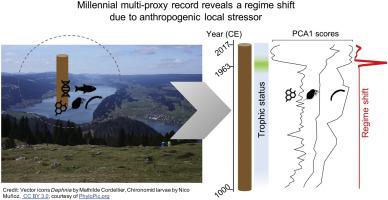Anthropocene ( IF 3.3 ) Pub Date : 2021-07-05 , DOI: 10.1016/j.ancene.2021.100301 Marie-Ève Monchamp 1, 2 , Rosalie Bruel 3 , Victor Frossard 3 , Suzanne McGowan 4 , Marlène Lavrieux 5 , Moritz Muschick 6, 7 , Marie-Élodie Perga 8 , Nathalie Dubois 2, 9

|
Freshwater ecosystems are under new and increasing threats from anthropogenic change. Ability to detect and predict consequences of environmental perturbations on ecosystem function and water quality is limited by the lack of empirical data over relevant time scales. Paleoecological records present a unique opportunity to broaden understanding of ecological transitions over decadal to millennial timescales. This study tested the occurrence of regime shifts to track changes throughout the lake food web beyond the typical instrumental era, using both “traditional” paleoecological proxies (e.g., cladoceran zooplankton, zoobenthos, and pigments) and more recently developed molecular genetic methods based on sedimentary DNA. We used sediment cores from the perialpine Lake Joux (Swiss Jura), where the history of human settlement and land-use practices in the catchment has been well documented since the Medieval period. Paleoecological evidence revealed an abrupt and unprecedented biological reorganization in the second half of the 20th century, following several centuries of relatively stable communities despite growing human pressure. Time-varying autoregression computed using dynamic linear modelling identified this transition, triggered by the onset of rapid cultural eutrophication in the 1950s, as a true regime shift. Since this time, despite decades of re-oligotrophication, biotic communities of Lake Joux have not returned to pre-disturbance composition, most likely due to other confounding factors, including climate warming, that may prevent the lake from returning to an earlier equilibrium state. Paleoecological reconstruction further suggested that cladocerans responded earlier to disturbance, which is highly relevant for lake monitoring and management strategies.
中文翻译:

周缘湖中多营养体系转变的古生态证据(瑞士茹湖)
淡水生态系统正面临人为变化带来的新的和日益增加的威胁。由于缺乏相关时间尺度的经验数据,检测和预测环境扰动对生态系统功能和水质的影响的能力受到限制。古生态记录提供了一个独特的机会,可以拓宽对十年到千年时间尺度的生态转变的理解。本研究使用“传统”古生态替代物(例如枝角类浮游动物、底栖动物和色素)和最近开发的基于沉积物的分子遗传方法,测试了制度转变的发生,以跟踪典型仪器时代之后整个湖泊食物网的变化。脱氧核糖核酸。我们使用了来自perialpine Lake Joux(瑞士侏罗)的沉积岩芯,自中世纪以来,流域中人类住区和土地使用实践的历史就已被很好地记录在案。古生态学证据表明,尽管人类压力越来越大,但在几个世纪以来相对稳定的社区之后,20 世纪下半叶发生了突然且前所未有的生物重组。使用动态线性模型计算的时变自回归将这种由 1950 年代快速文化富营养化引发的转变确定为真正的政权转变。从那时起,尽管经历了数十年的再贫营养化,茹湖的生物群落仍未恢复到干扰前的组成,这很可能是由于其他混杂因素,包括气候变暖,可能会阻止湖泊恢复到早期的平衡状态。










































 京公网安备 11010802027423号
京公网安备 11010802027423号